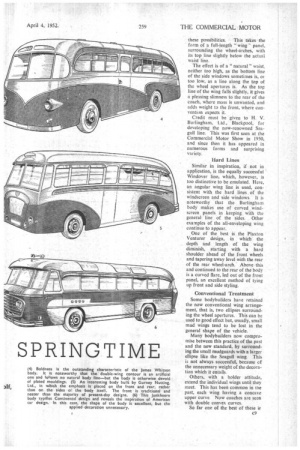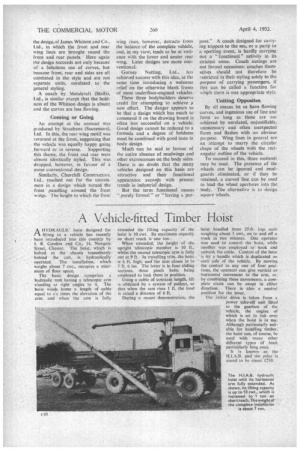SIDELINES SPRINGTIME
Page 44

Page 45

Page 46

If you've noticed an error in this article please click here to report it so we can fix it.
IN the spring, the operator's fancy lightly turns to what the coachbuilder has been worrying about all through the winter. Springtime, for the coach operator, is a time to forget about the mounting element of depreciation in his running costs, and to reflect happily on the extent to which new vehicles will boost his traffic statistics.
For the coachbuilder, spring is a time to supplant gloomy prognostications on the material-supply position by cheerful estimates of the record number of bodies which will be sold this year, based on the success which his newest model is sure to have.
A Trying Time It is also a time of experiment, for both operator and coachbuilder have to try out on their respective publics the style which the bodybuilder ha chosen. There seems little doubt that the trying-out period will not be prolonged this year, for already one style has shown itself to be more popular and acceptable than most others.
Such indications as there are show that many designers will follow the same line. Nevertheless, others retain an independent approach to the problem of designing a vehicle, which, after all, has to sell seats to the public on its external appearance.
The problem is not an easy one. Like the Paris dress designer, the coachbuilder has only a few basic features with which he can alter the outward appearance of the vehicle. Unlike the dress designer, all his models are roughly the same size, length, width and height. But the variations possible bear close relation to those used by the dress designer.
High or Low ?
A high waist, for example, makes a vehicle look shorter and fatter than it really is. A low one makes it look longer and slimmer. A deep skirt makes a coach look as if it is hugging the ground, and can be used to give a " ventre-A-terre" effect, which can be pleasing if the general lines of the vehicle suggest speed. This is not always popular, particularly when the operator knows the coach will be used where there are likely to be hump-back bridges or ferry-boats tkl deal with.
A high, raised skirt, on the other hand, can make a coach, particularly a small one, look awkward. If the line of the skirt rail is broken by individual wing outlines, it can give a most unwanted, " broken-back " appearance, not calculated to encourage dubious passengers.
It is therefore not surprising that designers have welcomed a mean of c8 these possibilities. This takes the form of a full-length " wing " panel, surrounding the wheel-arches, with its top line slightly below the actual waist line.
The effect is of a " natural " waist, neither too high, as the bottom line of the side windows sometimes is, or too low, as a line along the top of the wheel apertures is. As the top line of the wing falls slightly, it gives a pleasing slimness to the rear of the coach, where mass is unwanted, and adds weight to the front, where convention expects it.
Credit must be given to FT. V. Burlingham, 'Ltd., Blackpool, for developing the now-renowned Seagull line. This was first seen at the Commercial Motor Show in 1950, and since then it has appeared in numerous forms and surprising variety.
Hard Lines Similar in inspiration, if not in application, is the equally successful Windover line, which, however, is too distinctive to be emulated. Here, an angular wing line is used, consistent with the hard lines of the windscreen and side windows. It is noteworthy that the Burlingham body makes use of curved windscreen panels in keeping with the general line of the sides. Other examples of the all-enveloping wing continue to appear.
One of the best is the Plaxton Venturer design, in which the depth and length of the wing diminish, starting with a hard shoulder ahead of the front wheels and tapering away level with the rear of the rear wheel-arch. Above this and continued to the rear of the body is a curved flare, led out of the front panel, an excellent method of tying up front and side styling.
Conventional Treatment
Some bodybuilders have retained the now conventional wing arrangement, that is, two ellipses surrounding the wheel apertures. This can be used to good effect but, usually, small mud wings tend to be lost in the general shape of the vehicle.
Many bodybuilders now compromise between this practice of the past and the new standard, by surrounding the small mudguards with a larger ellipse like the Seagull wing. This is not always successful, because of the unnecessary weight of the decoration which it entails.
Others, with a bolder attitude, extend the individual wings until they meet. This has been common in the past, each wing having a concave upper curve Now coaches are seen with double convex curves.
So far one of the best of these c9
the design of James Whitson and Co., Ltd., in which the front and rear wing lines are brought round the front and rear panels. Here again the design succeeds not only because of a felicitous use of curves, but because front, rear and sides are all combined in the style and are not separate units, unrelated to the general styling.
A coach by Metalcraft (Staffs), Ltd., is similar except that the boldness of the Whitson design is absent and the curves are less flowing.
Coming or Going
• An attempt at the unusual was produced by Strachans (Successors), Ltd. In this, the rear wing motif was reversed at the front, suggesting that the vehicle was equally happy going
, forward or in reverse. Supporting this theme, the front and rear were almost identically styled. This was dropped, however, in favour of a more conventional design.
Churchill Constructors, Ltd., reached out for the tincOMMonin a design which turned the front panelling around. the front wings. The height to which the front
wing rises, however, detracts from the balance of the complete vehicle, and, in my view, tends to be at variance with the lower and neater rear wing. Later designs are more conventional.
Gurney Nutting, Ltd., has achieved success with this idea, at the same time introducing a welcome relief on the otherwise blank fronts of most tinderfloor-engined vehicles.
These three bodybuilders deserve credit for attempting to achieve ;a new effect. The danger appears to be that a design which has much to commend it on the drawing board is often less successful on a vehicle. Good design cannot be reduced to a formula and a degree of boldness must be combined with good taste in body design.
Much can be said in favour of the entire absence of mudwings and other excrescences on the body sides. There is no doubt that the many vehicles designed on this basis are attractive and their functional appearance accords with present trends in industriardesign.
But the term . functional means purely formal " or "having a pur pose." A coach designed for carrying trippers to the sea, or a party to a sporting event, is hardly carrying out a " functional " activity in its strictest sense. Coach outings are not formal occasions: coaches themselves should not therefore be restricted in their styling solely to the purpose of carrying passengers, if this can be called a function for which there is one appropriate style.
Uniting Opposites
By all means let its have flowing curves, and ingenious use of line and form so long as these are not achieved by unrelated, unjustifiable, unnecessary and often unexpected flares and flashes with no obvious purpose. Wing lines in general are an attempt to marry the circular shape of the wheels with the rectangular outline of the vehicle.
To-succeed in this, three methods may be used. The presence of the wheels can be ignored and mudguards eliminated, or if they be retained, a curved line can be used to lead the wheel apertures into the body. The alternative is to design square wheels.
























































































